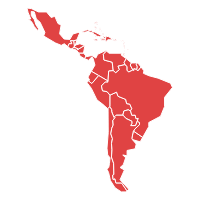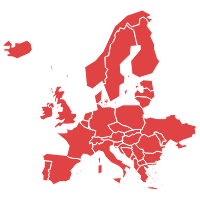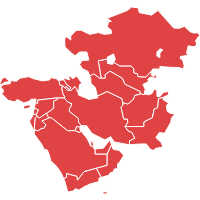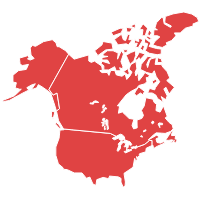- Frozen Sea Food
- Frozen Fruits & Vegetables
- Frozen Ready Meals
- Frozen Soups
- Frozen Meat & Poultry
- Others
Frozen Food Market size was valued at USD 354.12 billion in 2023 and is poised to grow at a CAGR of 7.1% from 2024 to 2030. Frozen foods are food products that can be deep frozen and stored and used for a long period. Freezing food reduces the decomposition by converting residual moisture into ice and inhibits the growth of bacterial species. Free can be done by two processes namely, cryogenic and mechanical. Most commonly used frozen food products include fruits & vegetables, poultry and meat, seafood, ready-to-meals, and soups among others. Frozen food is defined as food that has been frozen and kept at a low temperature for a long time. Ready meals, vegetables and fruits, potatoes, meat and poultry, seafood, and soup are among the food goods available on the market. Packaged ready-to-eat foods, bakeries, snacks, and desserts are also included in frozen-ready meals. Hotels, caterers, restaurants, and fast food chains are among the most frequent purchasers of frozen food goods such as frozen vegetables and fruits, potatoes, and non-vegetable products.
Frozen Food Market Summary
Study Period
2024-2030
Base Year
2023
CAGR
7.1%
Largest Market
North America
Fastest Growing Market
Asia pacific
Frozen Food Market Dynamics
Increase in the demand for frozen food in developed and developing countries is key factor drive the growth of frozen foods market. Moreover, change in food habits coupled with rise in disposable income, manufacturing of various ready-to-eat frozen food products, and better availability of products due to expansion of distribution channels are anticipated to bolster the frozen foods market over the forecast years. However, lack of suitable storage conditions in retail outlets, high cost and maintenance for the cryogenic food storage, and poor distribution facility in underdeveloped countries may restrain the growth of global frozen food market over the forecast years.
Key Features of the Reports
- The report provides granular level information about the market size, regional market share, historic market (2019-2023), and forecast (2024-2030)
- The report covers in-detail insights about the competitor’s overview, company share analysis, key market developments, and their key strategies
- The report outlines drivers, restraints, unmet needs, and trends that are currently affecting the market
- The report tracks recent innovations, key developments, and start-up details that are actively working in the market
- The report provides a plethora of information about market entry strategies, regulatory framework, and reimbursement scenario

Frozen Food Market Segmentation
By Product Type
By Distribution Channel
- Super markets & Hyper Markets
- Food Outlets
- Online Stores
- Others
By Geography
- North-America
- Asia Pacific
- Europe
- Latin America
Frequently Asked Questions
The frozen food market size was valued at USD 354.12 billion in 2023
The frozen food market key players are: McCain Foods Ltd. (Canada) General Mills Inc. (U.S) Tyson Foods Inc. (U.S.) ConAgra Foods Inc. (U.S.) J. Heinz Company (U.S.) Ajinomoto Co., Inc. (Japan) Kraft Food, Inc. (U.S.) Nestlé SA (Switzerland) Ralcorp Frozen Bakery Products, Inc. (U.S.) Unilever PLC (Netherlands)
The frozen food market has been classified into North America, Asia Pacific, Europe, Latin America, Middle East and Africa, and the rest of MEA.
| 1. Executive Summary |
| 2. Global Frozen Food Market Introduction |
| 2.1.Global Frozen Food Market - Taxonomy |
| 2.2.Global Frozen Food Market - Definitions |
| 2.2.1.Product Type |
| 2.2.2.Distribution Channel |
| 2.2.3.Region |
| 3. Global Frozen Food Market Dynamics |
| 3.1. Drivers |
| 3.2. Restraints |
| 3.3. Opportunities/Unmet Needs of the Market |
| 3.4. Trends |
| 3.5. Product Landscape |
| 3.6. New Product Launches |
| 3.7. Impact of COVID 19 on Market |
| 4. Global Frozen Food Market Analysis, 2019 - 2023 and Forecast 2024 - 2030 |
| 4.1. Market Analysis, 2019 - 2023 and Forecast, 2024 - 2030, (Sales Value USD Million) |
| 4.2. Year-Over-Year (Y-o-Y) Growth Analysis (%) |
| 4.3. Market Opportunity Analysis |
| 5. Global Frozen Food Market By Product Type, 2019 - 2023 and Forecast 2024 - 2030 (Sales Value USD Million) |
| 5.1. Frozen Sea Food |
| 5.1.1. Market Analysis, 2019 - 2023 and Forecast, 2024 - 2030, (Sales Value USD Million) |
| 5.1.2. Year-Over-Year (Y-o-Y) Growth Analysis (%) and Market Share Analysis (%) |
| 5.1.3. Market Opportunity Analysis |
| 5.2. Frozen Fruits & Vegetables |
| 5.2.1. Market Analysis, 2019 - 2023 and Forecast, 2024 - 2030, (Sales Value USD Million) |
| 5.2.2. Year-Over-Year (Y-o-Y) Growth Analysis (%) and Market Share Analysis (%) |
| 5.2.3. Market Opportunity Analysis |
| 5.3. Frozen Ready Meals |
| 5.3.1. Market Analysis, 2019 - 2023 and Forecast, 2024 - 2030, (Sales Value USD Million) |
| 5.3.2. Year-Over-Year (Y-o-Y) Growth Analysis (%) and Market Share Analysis (%) |
| 5.3.3. Market Opportunity Analysis |
| 5.4. Frozen Soups |
| 5.4.1. Market Analysis, 2019 - 2023 and Forecast, 2024 - 2030, (Sales Value USD Million) |
| 5.4.2. Year-Over-Year (Y-o-Y) Growth Analysis (%) and Market Share Analysis (%) |
| 5.4.3. Market Opportunity Analysis |
| 5.5. Frozen Meat & Poultry |
| 5.5.1. Market Analysis, 2019 - 2023 and Forecast, 2024 - 2030, (Sales Value USD Million) |
| 5.5.2. Year-Over-Year (Y-o-Y) Growth Analysis (%) and Market Share Analysis (%) |
| 5.5.3. Market Opportunity Analysis |
| 5.6. Others |
| 5.6.1. Market Analysis, 2019 - 2023 and Forecast, 2024 - 2030, (Sales Value USD Million) |
| 5.6.2. Year-Over-Year (Y-o-Y) Growth Analysis (%) and Market Share Analysis (%) |
| 5.6.3. Market Opportunity Analysis |
| 6. Global Frozen Food Market By Distribution Channel, 2019 - 2023 and Forecast 2024 - 2030 (Sales Value USD Million) |
| 6.1. Super markets & Hyper Markets |
| 6.1.1. Market Analysis, 2019 - 2023 and Forecast, 2024 - 2030, (Sales Value USD Million) |
| 6.1.2. Year-Over-Year (Y-o-Y) Growth Analysis (%) and Market Share Analysis (%) |
| 6.1.3. Market Opportunity Analysis |
| 6.2. Food Outlets |
| 6.2.1. Market Analysis, 2019 - 2023 and Forecast, 2024 - 2030, (Sales Value USD Million) |
| 6.2.2. Year-Over-Year (Y-o-Y) Growth Analysis (%) and Market Share Analysis (%) |
| 6.2.3. Market Opportunity Analysis |
| 6.3. Online Stores |
| 6.3.1. Market Analysis, 2019 - 2023 and Forecast, 2024 - 2030, (Sales Value USD Million) |
| 6.3.2. Year-Over-Year (Y-o-Y) Growth Analysis (%) and Market Share Analysis (%) |
| 6.3.3. Market Opportunity Analysis |
| 6.4. Others |
| 6.4.1. Market Analysis, 2019 - 2023 and Forecast, 2024 - 2030, (Sales Value USD Million) |
| 6.4.2. Year-Over-Year (Y-o-Y) Growth Analysis (%) and Market Share Analysis (%) |
| 6.4.3. Market Opportunity Analysis |
| 7. Global Frozen Food Market By Region, 2019 - 2023 and Forecast 2024 - 2030 (Sales Value USD Million) |
| 7.1. North America |
| 7.1.1. Market Analysis, 2019 - 2023 and Forecast, 2024 - 2030, (Sales Value USD Million) |
| 7.1.2. Year-Over-Year (Y-o-Y) Growth Analysis (%) and Market Share Analysis (%) |
| 7.1.3. Market Opportunity Analysis |
| 7.2. Europe |
| 7.2.1. Market Analysis, 2019 - 2023 and Forecast, 2024 - 2030, (Sales Value USD Million) |
| 7.2.2. Year-Over-Year (Y-o-Y) Growth Analysis (%) and Market Share Analysis (%) |
| 7.2.3. Market Opportunity Analysis |
| 7.3. Asia Pacific (APAC) |
| 7.3.1. Market Analysis, 2019 - 2023 and Forecast, 2024 - 2030, (Sales Value USD Million) |
| 7.3.2. Year-Over-Year (Y-o-Y) Growth Analysis (%) and Market Share Analysis (%) |
| 7.3.3. Market Opportunity Analysis |
| 7.4. Middle East and Africa (MEA) |
| 7.4.1. Market Analysis, 2019 - 2023 and Forecast, 2024 - 2030, (Sales Value USD Million) |
| 7.4.2. Year-Over-Year (Y-o-Y) Growth Analysis (%) and Market Share Analysis (%) |
| 7.4.3. Market Opportunity Analysis |
| 7.5. Latin America |
| 7.5.1. Market Analysis, 2019 - 2023 and Forecast, 2024 - 2030, (Sales Value USD Million) |
| 7.5.2. Year-Over-Year (Y-o-Y) Growth Analysis (%) and Market Share Analysis (%) |
| 7.5.3. Market Opportunity Analysis |
| 8. North America Frozen Food Market,2019 - 2023 and Forecast 2024 - 2030 (Sales Value USD Million) |
| 8.1. Product Type Analysis 2019 - 2023 and Forecast 2024 - 2030 by Sales Value USD Million, Y-o-Y Growth (%), and Market Share (%) |
| 8.1.1.Frozen Sea Food |
| 8.1.2.Frozen Fruits & Vegetables |
| 8.1.3.Frozen Ready Meals |
| 8.1.4.Frozen Soups |
| 8.1.5.Frozen Meat & Poultry |
| 8.1.6.Others |
| 8.2. Distribution Channel Analysis 2019 - 2023 and Forecast 2024 - 2030 by Sales Value USD Million, Y-o-Y Growth (%), and Market Share (%) |
| 8.2.1.Super markets & Hyper Markets |
| 8.2.2.Food Outlets |
| 8.2.3.Online Stores |
| 8.2.4.Others |
| 8.3. Country Analysis 2019 - 2023 and Forecast 2024 - 2030 by Sales Value USD Million, Y-o-Y Growth (%), and Market Share (%) |
| 8.3.1.United States of America (USA) |
| 8.3.2.Canada |
| 9. Europe Frozen Food Market,2019 - 2023 and Forecast 2024 - 2030 (Sales Value USD Million) |
| 9.1. Product Type Analysis and Forecast by Sales Value USD Million, Y-o-Y Growth (%), and Market Share (%) |
| 9.1.1.Frozen Sea Food |
| 9.1.2.Frozen Fruits & Vegetables |
| 9.1.3.Frozen Ready Meals |
| 9.1.4.Frozen Soups |
| 9.1.5.Frozen Meat & Poultry |
| 9.1.6.Others |
| 9.2. Distribution Channel Analysis 2019 - 2023 and Forecast 2024 - 2030 by Sales Value USD Million, Y-o-Y Growth (%), and Market Share (%) |
| 9.2.1.Super markets & Hyper Markets |
| 9.2.2.Food Outlets |
| 9.2.3.Online Stores |
| 9.2.4.Others |
| 9.3. Country Analysis 2019 - 2023 and Forecast 2024 - 2030 by Sales Value USD Million, Y-o-Y Growth (%), and Market Share (%) |
| 9.3.1.Germany |
| 9.3.2.France |
| 9.3.3.Italy |
| 9.3.4.United Kingdom (UK) |
| 9.3.5.Spain |
| 9.3.6.Rest of EU |
| 10. Asia Pacific (APAC) Frozen Food Market,2019 - 2023 and Forecast 2024 - 2030 (Sales Value USD Million) |
| 10.1. Product Type Analysis and Forecast by Sales Value USD Million, Y-o-Y Growth (%), and Market Share (%) |
| 10.1.1.Frozen Sea Food |
| 10.1.2.Frozen Fruits & Vegetables |
| 10.1.3.Frozen Ready Meals |
| 10.1.4.Frozen Soups |
| 10.1.5.Frozen Meat & Poultry |
| 10.1.6.Others |
| 10.2. Distribution Channel Analysis 2019 - 2023 and Forecast 2024 - 2030 by Sales Value USD Million, Y-o-Y Growth (%), and Market Share (%) |
| 10.2.1.Super markets & Hyper Markets |
| 10.2.2.Food Outlets |
| 10.2.3.Online Stores |
| 10.2.4.Others |
| 10.3. Country Analysis 2019 - 2023 and Forecast 2024 - 2030 by Sales Value USD Million, Y-o-Y Growth (%), and Market Share (%) |
| 10.3.1.China |
| 10.3.2.India |
| 10.3.3.Australia and New Zealand (ANZ) |
| 10.3.4.Japan |
| 10.3.5.Rest of APAC |
| 11. Middle East and Africa (MEA) Frozen Food Market,2019 - 2023 and Forecast 2024 - 2030 (Sales Value USD Million) |
| 11.1. Product Type Analysis and Forecast by Sales Value USD Million, Y-o-Y Growth (%), and Market Share (%) |
| 11.1.1.Frozen Sea Food |
| 11.1.2.Frozen Fruits & Vegetables |
| 11.1.3.Frozen Ready Meals |
| 11.1.4.Frozen Soups |
| 11.1.5.Frozen Meat & Poultry |
| 11.1.6.Others |
| 11.2. Distribution Channel Analysis 2019 - 2023 and Forecast 2024 - 2030 by Sales Value USD Million, Y-o-Y Growth (%), and Market Share (%) |
| 11.2.1.Super markets & Hyper Markets |
| 11.2.2.Food Outlets |
| 11.2.3.Online Stores |
| 11.2.4.Others |
| 11.3. Country Analysis 2019 - 2023 and Forecast 2024 - 2030 by Sales Value USD Million, Y-o-Y Growth (%), and Market Share (%) |
| 11.3.1.GCC Countries |
| 11.3.2.South Africa |
| 11.3.3.Rest of MEA |
| 12. Latin America Frozen Food Market,2019 - 2023 and Forecast 2024 - 2030 (Sales Value USD Million) |
| 12.1. Product Type Analysis and Forecast by Sales Value USD Million, Y-o-Y Growth (%), and Market Share (%) |
| 12.1.1.Frozen Sea Food |
| 12.1.2.Frozen Fruits & Vegetables |
| 12.1.3.Frozen Ready Meals |
| 12.1.4.Frozen Soups |
| 12.1.5.Frozen Meat & Poultry |
| 12.1.6.Others |
| 12.2. Distribution Channel Analysis 2019 - 2023 and Forecast 2024 - 2030 by Sales Value USD Million, Y-o-Y Growth (%), and Market Share (%) |
| 12.2.1.Super markets & Hyper Markets |
| 12.2.2.Food Outlets |
| 12.2.3.Online Stores |
| 12.2.4.Others |
| 12.3. Country Analysis 2019 - 2023 and Forecast 2024 - 2030 by Sales Value USD Million, Y-o-Y Growth (%), and Market Share (%) |
| 12.3.1.Brazil |
| 12.3.2.Mexico |
| 12.3.3.Rest of LA |
| 13. Competition Landscape |
| 13.1. Market Player Profiles (Introduction, Brand/Product Sales, Financial Analysis, Product Offerings, Key Developments, Collaborations, M & A, Strategies, and SWOT Analysis) |
| 13.2.1.McCain Foods Ltd. (Canada) |
| 13.2.2.General Mills Inc. (U.S) |
| 13.2.3.Tyson Foods Inc. (U.S.) |
| 13.2.4.ConAgra Foods Inc. (U.S.) |
| 13.2.5.J. Heinz Company (U.S.) |
| 13.2.6.Ajinomoto Co., Inc. (Japan) |
| 13.2.7.Kraft Food, Inc. (U.S.) |
| 13.2.8.Nestlé SA (Switzerland) |
| 13.2.9.Ralcorp Frozen Bakery Products, Inc. (U.S.) |
| 13.2.10.Unilever PLC (Netherlands) |
| 14. Research Methodology |
| 15. Appendix and Abbreviations |
- McCain Foods Ltd. (Canada)
- General Mills Inc. (U.S)
- Tyson Foods Inc. (U.S.)
- ConAgra Foods Inc. (U.S.)
- J. Heinz Company (U.S.)
- Ajinomoto Co., Inc. (Japan)
- Kraft Food, Inc. (U.S.)
- Nestlé SA (Switzerland)
- Ralcorp Frozen Bakery Products, Inc. (U.S.)
- Unilever PLC (Netherlands)




